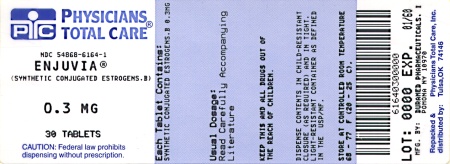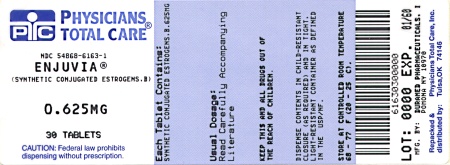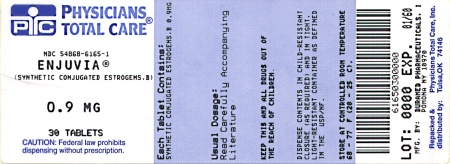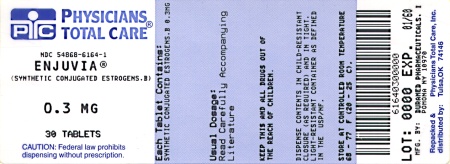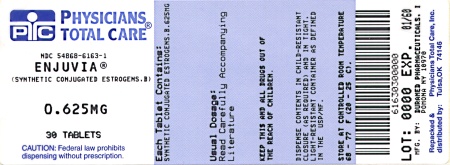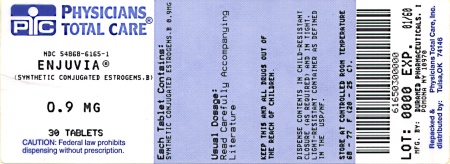Label: ENJUVIA- synthetic conjugated estrogens, b tablet
-
Contains inactivated NDC Code(s)
NDC Code(s): 54868-6163-0, 54868-6163-1, 54868-6164-0, 54868-6164-1, view more54868-6165-0, 54868-6165-1 - Packager: Physicians Total Care, Inc.
- This is a repackaged label.
- Source NDC Code(s): 51285-406, 51285-408, 51285-409
- Category: HUMAN PRESCRIPTION DRUG LABEL
Drug Label Information
Updated March 1, 2010
If you are a healthcare professional or from the pharmaceutical industry please visit this version.
- Download DRUG LABEL INFO: PDF XML
- Official Label (Printer Friendly)
-
SPL UNCLASSIFIED SECTION
11001651
Rx only
ESTROGENS INCREASE THE RISK OF ENDOMETRIAL CANCER
Close clinical surveillance of all women taking estrogens is important. Adequate diagnostic measures, including endometrial sampling when indicated, should be undertaken to rule out malignancy in all cases of undiagnosed persistent or recurring abnormal vaginal bleeding. There is no evidence that the use of “natural” estrogens results in a different endometrial risk profile than synthetic estrogens at equivalent estrogen doses. (See WARNINGS, Malignant neoplasms, Endometrial cancer.)
CARDIOVASCULAR AND OTHER RISKS
Estrogens with or without progestins should not be used for the prevention of cardiovascular disease or dementia. (See CLINICAL STUDIES and WARNINGS, Cardiovascular disorders and Dementia.)
The estrogen alone substudy of the Women’s Health Initiative (WHI) reported increased risks of stroke and deep vein thrombosis (DVT) in postmenopausal women (50 to 79 years of age) during 6.8 years and 7.1 years, respectively, of treatment with oral conjugated estrogens (CE 0.625 mg) alone per day, relative to placebo. (See CLINICAL STUDIES and WARNINGS, Cardiovascular disorders.)
The estrogen-plus-progestin substudy of the WHI reported increased risks of myocardial infarction, stroke, invasive breast cancer, pulmonary emboli, and deep vein thrombosis in postmenopausal women (50 to 79 years of age) during 5.6 years of treatment with oral conjugated estrogens (CE 0.625 mg) combined with medroxyprogesterone acetate (MPA 2.5 mg) per day, relative to placebo. (See CLINICAL STUDIES, and WARNINGS, Cardiovascular disorders and Malignant neoplasms, Breast cancer).
The Women’s Health Initiative Memory Study (WHIMS), a substudy of WHI study, reported increased risk of developing probable dementia in postmenopausal women 65 years of age or older during 5.2 years of treatment with CE 0.625 mg alone and during 4 years of treatment with CE 0.625 mg combined with MPA 2.5 mg, relative to placebo. It is unknown whether this finding applies to younger postmenopausal women. (See CLINICAL STUDIES, WARNINGS, Dementia and PRECAUTIONS, Geriatric Use.)
Other doses of conjugated estrogens and medroxyprogesterone acetate, and other combinations and dosage forms of estrogens and progestins, were not studied in the WHI clinical trials, and in the absence of comparable data, these risks should be assumed to be similar. Because of these risks, estrogens with or without progestins should be prescribed at the lowest effective doses and for the shortest duration consistent with treatment goals and risks for the individual woman.
-
DESCRIPTION
ENJUVIA® (synthetic conjugated estrogens, B) tablets contain a blend of ten (10) synthetic estrogenic substances. The estrogenic substances are: sodium estrone sulfate, sodium equilin sulfate, sodium 17α-dihydroequilin sulfate, sodium 17α-estradiol sulfate, sodium 17β-dihydroequilin sulfate, sodium 17α-dihydroequilenin sulfate, sodium 17β-dihydroequilenin sulfate, sodium equilenin sulfate, sodium 17β-estradiol sulfate, and sodium Δ8,9-dehydroestrone sulfate.
The structural formulae for these estrogens are:

Sodium Estrone Sulfate

Sodium Equilin Sulfate
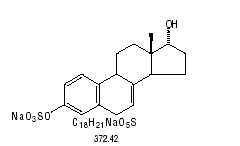
Sodium 17α-Dihydroequilin Sulfate
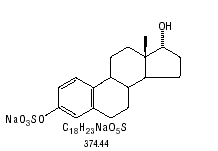
Sodium 17α-Estradiol Sulfate

Sodium 17β-Dihydroequilenin Sulfate
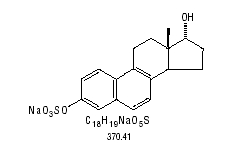
Sodium 17α-Dihydroequilenin Sulfate
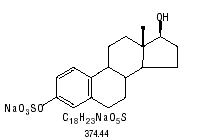
Sodium 17β-Estradiol Sulfate
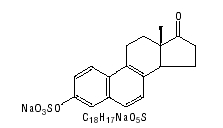
Sodium Equilenin Sulfate
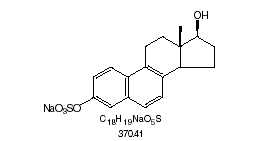
Sodium 17β-Dihydroequilenin Sulfate
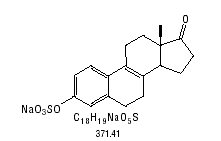
Sodium Δ8,9 dehydroestrone Sulfate
ENJUVIA tablets for oral administration are available in 0.3 mg, 0.45 mg, 0.625 mg, 0.9 mg and 1.25 mg strengths of synthetic conjugated estrogens, B. These tablets contain the following inactive ingredients: ascorbyl palmitate, butylated hydroxyanisole, colloidal silicon dioxide, edetate disodium dehydrate, plasticized ethylcellulose, hypromellose, lactose monohydrate, magnesium stearate, purified water, iron oxide red, titanium dioxide, polyethylene glycol, polysorbate 80, triacetate and triacetin/glycerol. In addition, the 0.45 mg tablets contain iron oxide black and iron oxide yellow; the 0.9 mg tablets also contain D&C yellow no. 10 aluminum lake, FD&C blue no. 1 aluminum lake and FD&C yellow no. 6 aluminum lake; and the 1.25 mg tablets contain iron oxide yellow.
-
CLINICAL PHARMACOLOGY
Endogenous estrogens are largely responsible for the development and maintenance of the female reproductive system and secondary sexual characteristics. Although circulating estrogens exist in a dynamic equilibrium of metabolic interconversions, estradiol is the principal intracellular human estrogen and is substantially more potent than its metabolites, estrone and estriol, at the receptor level.
The primary source of estrogen in normally cycling adult women is the ovarian follicle, which secretes 70 to 500 mcg of estradiol daily, depending on the phase of the menstrual cycle. After menopause, most endogenous estrogen is produced by conversion of androstenedione, secreted by the adrenal cortex, to estrone by peripheral tissues. Thus, estrone and the sulfate-conjugated form, estrone sulfate, are the most abundant circulating estrogens in postmenopausal women.
Estrogens act through binding to nuclear receptors in estrogen-responsive tissues. To date, two estrogen receptors have been identified. These vary in proportion from tissue to tissue.
Circulating estrogens modulate the pituitary secretion of the gonadotropins, luteinizing hormone (LH) and follicle-stimulating hormone (FSH), through a negative feedback mechanism. Estrogens act to reduce the elevated levels of these hormones in postmenopausal women.
A. Absorption
Synthetic conjugated estrogens, B are soluble in water and are well absorbed from the gastrointestinal tract after release from the drug formulation. ENJUVIA tablets release synthetic conjugated estrogens, B slowly over a period of several hours. Table 1 and Table 2 summarize the mean pharmacokinetic parameters for unconjugated (free) and conjugated (total) estrogens following single administration of two 0.625 mg tablets to 21 healthy postmenopausal women under fasting conditions. The effect of food on the bioavailability of synthetic conjugated estrogens, B following administration of ENJUVIA tablets has not been studied. However, the presence of food did not significantly affect the pharmacokinetics of a similar formulation of synthetic conjugated estrogens, B.
Table 1. Mean Pharmacokinetic Parameters of Unconjugated (Free) Estrogens Following a Single Dose of 2 x 0.625 mg ENJUVIA Tablets Under Fasting Conditions* Cmax = peak plasma concentration; tmax = time peak concentration occurs; t1/2 = apparent terminal-phase disposition half-life. AUC0-48h = total area under the concentration-time curve from time zero to time of last quantifiable concentration (48h) ; * Δ8,9 Dehydroestrone (free) levels were below the assay limit of quantitation; CV= Coefficient of Variance Cmax
(pg/mL)tmax
(hr)t1/2
(hr)AUC0-48h
(pg●hr/mL)Baseline-corrected estrone
(% CV)75.87
(39)9.29
(25)23.46
(59)1601.59
(41)Equilin
(% CV)41.94
(49)8.38
(27)15.09
(55)707.21
(46)Table 2. Mean Pharmacokinetic Parameters of Conjugated (Total) Estrogens Following a Single Dose of 2 x 0.625 mg ENJUVIA Tablets Under Fasting Conditions Cmax = peak plasma concentration; tmax = time peak concentration occurs; t1/2 = apparent terminal-phase disposition half-life; AUC0-48h = total area under the concentration-time curve from time zero to time of last quantifiable concentration (48h); CV= Coefficient of Variance Cmax
(ng/mL)tmax
(h)t1/2
(h)AUC0-48h
(ng●h/mL)Baseline-corrected estrone
(% CV)3.74
(29)8.00
(27)14.26
(26)62.03
(34)Equilin
(% CV)3.69
(44)8.05
(36)11.28
(28)58.25
(53)Δ8,9 Dehydroestrone
(%CV)0.74
(32)7.55
(37)14.14
(26)12.93
(39)B. Distribution
The distribution of exogenous estrogens is similar to that of endogenous estrogens. Estrogens are widely distributed in the body and are generally found in higher concentrations in the sex hormone target organs. Estrogens circulate in the blood largely bound to sex hormone binding globulin (SHBG) and albumin.
C. Metabolism
Exogenous estrogens are metabolized in the same manner as endogenous estrogens. Circulating estrogens exist in a dynamic equilibrium of metabolic interconversions. These transformations take place mainly in the liver. Estradiol is converted reversibly to estrone, and both can be converted to estriol, which is the major urinary metabolite. Estrogens also undergo enterohepatic recirculation via sulfate and glucuronide conjugation in the liver, biliary secretion of conjugates into the intestine, and hydrolysis in the intestine followed by reabsorption. In postmenopausal women, a significant portion of the circulating estrogens exists as sulfate conjugates, especially estrone sulfate, which serves as a circulating reservoir for the formation of more active estrogens.
D. Excretion
Estradiol, estrone, and estriol are excreted in the urine along with glucuronide and sulfate conjugates. The mean (SD) apparent terminal elimination half-life (t½) of conjugated estrone is 14 (± 6) hours and conjugated equilin is 11 (± 6) hours.
E. Special Populations
No pharmacokinetic studies were conducted in special populations, including patients with renal or hepatic impairment.
F. Drug Interactions
In vitro and in vivo studies have shown that estrogens are metabolized partially by cytochrome P450 3A4 (CYP3A4). Therefore, inducers or inhibitors of CYP3A4 may affect estrogen drug metabolism. Inducers of CYP3A4, such as St. John’s Wort preparations (Hypericum perforatum), phenobarbital, carbamazepine, and rifampin, may reduce plasma concentrations of estrogens, possibly resulting in a decrease in therapeutic effects and/or changes in the uterine bleeding profile. Inhibitors of CYP3A4, such as erythromycin, clarithromycin, ketoconazole, itraconazole, ritonavir, and grapefruit juice, may increase plasma concentrations of estrogens and may result in side effects.
-
CLINICAL STUDIES
Effects on Vasomotor Symptoms
A randomized, double-blind, placebo-controlled, dose-ranging, multi-center clinical study was conducted to evaluate the safety and effectiveness of ENJUVIA tablets for the treatment of vasomotor symptoms in 281 naturally or surgically postmenopausal women aged 26 to 65 years who were experiencing a minimum of seven moderate to severe hot flushes per day or 50 per week at randomization. The majority (81%) of patients were Caucasian (n=228) and 17.4% were Black (n=49). Patients were randomized to receive ENJUVIA tablets 0.3 mg, 0.625 mg, 1.25 mg, or placebo once daily for 12 weeks.
ENJUVIA (0.3 mg, 0.625 mg and 1.25 mg tablets) was shown to be statistically better than placebo at weeks 4 and 12 for relief of both the frequency and severity of moderate to severe vasomotor symptoms (Table 3 and 4).
Table 3. Mean Number and Mean Change in Number of Moderate to Severe Hot Flushes Per Week ITT Population With LOCF ITT= Intent to treat; LOCF= Last Observation Carried Forward, SD= Standard Deviation; SE= Standard Error 0.3 mg
n=660.625 mg
n=711.25 mg
n=69Placebo
n=70Baseline Mean (SD) 104.3 (57.7) 97.3 (82.1) 86.8 (42.1) 96.4 (58.2) Week 4 Mean (SD) 47.0 (52.9) 23.3 (26.9) 24.6 (47.0) 57.8 (47.5) Mean Change from
Baseline (SE)-49.8 (5.2) -72.8 (5.0) -68.3 (5.1) -37.2 (5.0) p-value versus placebo 0.005 <0.001 <0.001 --- Week 12 Mean (SD) 30.7 (47.7) 12.2 (18.7) 12.4 (26.3) 47.5 (49.8) Mean Change from
Baseline (SE)-66.3 (4.6) -84.6 (4.4) -82.6 (4.5) -48.3 (4.5) p-value versus placebo <0.001 <0.001 <0.001 --- Table 4. Mean Change in Severity of Moderate to Severe Hot Flushes Per Week, ITT Population with LOCF ITT= Intent to treat; LOCF= Last Observation Carried Forward, SD= Standard Deviation; SE= Standard Error 0.3 mg
n=660.625 mg
n=711.25 mg
n=69Placebo
n=70Baseline Mean (SD) 2.5 (0.3) 2.5 (0.3) 2.5 (0.3) 2.5 (0.3) Week 4 Mean (SD) 2.1 (0.8) 1.9 (1.0) 1.5 (1.1) 2.2 (0.8) Mean Change from
Baseline (SE)-0.5 (0.1) -0.6 (0.1) -1.0 (0.1) -0.3 (0.1) p-value versus placebo 0.036 0.002 <0.001 --- Week 12 Mean (SD) 1.5 (1.2) 1.1 (1.2) 1.0 (1.1) 1.9 (1.1) Mean Change from
Baseline (SE)-1.0 (0.1) -1.4 (0.1) -1.5 (0.1) -0.6 (0.1) p-value versus placebo 0.023 <0.001 <0.001 --- Effects on Vulvar and Vaginal Atrophy
A randomized, double-blind, placebo-controlled, multi-center clinical study was conducted to evaluate the safety and effectiveness of ENJUVIA 0.3 mg tablets for the treatment of symptoms of vulvar and vaginal atrophy in 248 naturally or surgically postmenopausal women between 32 to 81 years of age (mean 58.6 years) who at baseline had ≤ 5% superficial cells on a vaginal smear, a vaginal pH > 5.0, and who identified their most bothersome moderate to severe symptom of vulvar and vaginal atrophy. The majority (82%) of the women were Caucasian (n=203), 11% were Hispanic (n=26), 4% were Black (n=9) and 3% were Asian (n=6). All patients were assessed for improvement in the mean change from baseline to Week 12 for three co-primary efficacy variables: most bothersome symptom of vulvar and vaginal atrophy (defined as the moderate to severe symptom that had been identified by the patient as most bothersome to her at baseline); percentage of vaginal superficial cells and percentage of vaginal parabasal cells; and vaginal pH.
In this study, a statistically significant mean change between baseline and week 12 for the group treated with ENJUVIA 0.3 mg tablets compared to placebo was observed for the symptoms, vaginal dryness and pain with intercourse. See Table 5. ENJUVIA 0.3 mg tablets increased superficial cells by a mean of 17.1% as compared to 2.0% for placebo (statistically significant). A corresponding statistically significant mean reduction from baseline in parabasal cells (41.7% for ENJUVIA 0.3 mg tablets and 6.8% for placebo) was observed at week 12. The mean reduction between baseline and week 12 in the pH was 1.69 in the ENJUVIA 0.3 mg tablets group and 0.45 in the placebo group (statistically significant).
Table 5. Change from Baseline to Week 12 in the Severity of Vaginal Dryness and Pain with Intercourse, Symptoms That Were Identified by the Menopausal Study Patient as Her Most Bothersome Symptom of Vulvar and Vaginal Atrophy at Baseline * Treatment differences assessed by ANCOVA or rank ANCOVA (% cell data) with baseline as covariate for the modified intent-to-treat population, last-observation-carried-forward data set. Most Bothersome Symptom at Baseline* ENJUVIA 0.3 mg Placebo Vaginal Dryness n 56 54 Baseline Severity 2.52 2.54 Mean Severity at Week 12 0.80 1.81 Mean Change in Severity from Baseline (s.d.) -1.71 (0.85)
-0.72 (0.66) p-value vs. placebo <0.001 --- Pain With Intercourse n 35 40 Baseline Severity 2.74 2.70 Mean Severity at Week 12 0.94 1.95 Mean Change in Severity from Baseline (s.d.) -1.80 (1.02) -0.75 (0.95) p-value vs. placebo <0.001 --- Women’s Health Initiative Studies
The WHI enrolled approximately 27,000 predominantly healthy postmenopausal women in two substudies to assess the risks and benefits of either the use of oral conjugated estrogens (CE 0.625 mg) alone per day or in combination with medroxyprogesterone acetate (CE 0.625 mg/MPA 2.5 mg) per day compared to placebo in the prevention of certain chronic diseases. The primary endpoint was the incidence of coronary heart disease (CHD) (nonfatal myocardial infarction (MI), silent MI and CHD death), with invasive breast cancer as the primary adverse outcome studied. A “global index” included the earliest occurrence of CHD, invasive breast cancer, stroke, pulmonary embolism (PE), endometrial cancer (only in the estrogen plus progestin substudy), colorectal cancer, hip fracture, or death due to other causes. The study did not evaluate the effects of CE or CE/MPA on menopausal symptoms.
The estrogen-alone substudy was stopped early because an increased risk of stroke was observed and it was deemed that no further information would be obtained regarding the risks and benefits of estrogen alone in predetermined primary endpoints. Results of the estrogen-alone substudy, which included 10,739 women (average age of 63 years, range 50 to 79; 75.3% White, 15.1% Black, 6.1% Hispanic, 3.6% Other), after an average follow-up of 6.8 years are presented in Table 6.
Table 6: Relative And Absolute Risk Seen In The Estrogen-Alone Substudy Of WHI* Event Relative Risk
CE vs. Placebo
(95% nCI* )Placebo
n = 5,429CE
n = 5,310Absolute Risk per 10,000
Women-YearsCHD events†
Nonfatal MI†
CHD death†0.95 (0.79- 1.16)
0.91 (0.73-1.14)
1.01(0.71- 1.43)56
43
1653
40
16Stroke‡ 1.39 (1.10-1.77) 32 44 Deep vein thrombosis†,§ 1.47 (1.06-2.06) 15 23 Pulmonary embolism† 1.37 (0.90-2.07) 10 14 Invasive breast cancer† 0.80 (0.62-1.04) 34 28 Colorectal cancer‡ 1.08 (0.75-1.55) 16 17 Hip fracture‡ 0.61 (0.41-0.91) 17 11 Vertebral fractures‡, § 0.62 (0.42-0.93) 17 11 Total fractures‡, § 0.70 (0.63-0.79) 195 139 Death due to other causes‡, 1.08 (0.88-1.32) 50 53 Overall mortality‡, § 1.04 (0.88-1.32) 78 81 Global index‡, 1.01 (0.91-1.12) 190 192 For those outcomes included in the WHI “global index” that reached statistical significance, the absolute excess risk per 10,000 women-years in the group treated with estrogen-alone was 12 more strokes, while the absolute risk reduction per 10,000 women-years was 6 fewer hip fractures. The absolute excess risk of events included in the “global index” was a nonsignificant 2 events per 10,000 women-years. There was no difference between the groups in terms of all-cause mortality. (See BOXED WARNINGS, WARNINGS, and PRECAUTIONS.)
Final centrally adjudicated results for CHD events and centrally adjudicated results for invasive breast cancer incidence from the estrogen-alone substudy, after an average follow-up of 7.1 years, reported no overall difference for primary CHD events (nonfatal MI, silent MI and CHD death) and invasive breast cancer incidence in women receiving CE alone compared with placebo (see Table 6).
The estrogen-plus-progestin substudy was also stopped early because, according to the predefined stopping rule, after an average follow-up of 5.2 years of treatment, the increased risk of breast cancer and cardiovascular events exceeded the specified benefits included in the “global index.” The absolute excess risk of events included in the “global index” was 19 per 10,000 women-years (RR 1.15, 95% nCI 1.03-1.28).
For those outcomes included in the WHI “global index” that reached statistical significance after 5.6 years of follow-up, the absolute excess risks per 10,000 women-years in the group treated with CE/MPA were 6 more CHD events, 7 more strokes, 10 more PEs, and 8 more invasive breast cancers, while the absolute risk reductions per 10,000 women-years were 7 fewer colorectal cancers and 5 fewer hip fractures. (See BOXED WARNINGS, WARNINGS, and PRECAUTIONS.)
Results of the estrogen-plus-progestin substudy, which included 16,608 women (average age of 63 years, range 50 to 79; 83.9% White, 6.8% Black, 5.4% Hispanic, 3.9% Other) are presented in Table 7 below.
Table 7. Relative And Absolute Risk Seen in the Estrogen-Plus Progestin Substudy of WHI at an Average of 5.6 Years Event Relative Risk
CE/MPA vs. Placebo
(95% nCI )Placebo
n = 8102CE/MPA
n = 8506Absolute Risk per 10,000
Women-YearsCHD events
Non-fatal MI
CHD death1.24 (1.00-1.54)
1.28 (1.00-1.63)
1.10 (0.70-1.75)33
25
839
31
8All strokes 1.31 (1.02-1.68) 24 31 Ischemic stroke 1.44 (1.09 -1.90) 18 26 Deep vein thrombosis 1.95 (1.43 – 2.67) 13 26 Pulmonary embolism 2.13 (1.45-3.11) 8 18 Invasive breast cancer 1.24 (1.01-1.54) 3 41 Invasive colorectal cancer 0.56 (0.38-0.81) 16 9 Endometrial cancer 0.81 (0.48-1.36) 7 6 Cervical cancer 1.44 (0.47-4.42) 1 2 Hip fracture 0.67 (0.47-0.96) 16 11 Vertebral fractures 0.65 (0.46-0.92) 17 11 Lower arm/wrist fractures 0.71 (0.59-0.85) 62 44 Total fractures 0.76 (0.69-0.83) 199 152 Women’s Health Initiative Memory Study
The estrogen-alone Women’s Health Initiative Memory Study (WHIMS), a substudy of WHI study, enrolled 2,947 predominantly healthy postmenopausal women 65 years of age and older (45% were age 65 to 69 years, 36% were 70 to 74 years, and 19% were 75 years of age and older) to evaluate the effects of conjugated estrogens (CE 0.625 mg) on the incidence of probable dementia (primary outcome) compared with placebo.
After an average follow-up of 5.2 years, 28 women in the estrogen-alone group (37 per 10,000 women-years) and 19 in the placebo group (25 per 10,000 women-years) were diagnosed with probable dementia. The relative risk of probable dementia in the estrogen-alone group was 1.49 (95% CI 0.83-2.66) compared to placebo. It is unknown whether these findings apply to younger postmenopausal women. (See BOXED WARNINGS, WARNINGS, Dementia and PRECAUTIONS, Geriatric Use.)
The estrogen-plus-progestin WHIMS substudy enrolled 4,532 predominantly healthy postmenopausal women 65 years of age and older (47% were aged 65 to 69 years, 35% were 70 to 74 years, and 18% were 75 years of age and older) to evaluate the effects of CE 0.625 mg plus MPA 2.5 mg on the incidence of probable dementia (primary outcome) compared with placebo.
After an average follow-up of 4 years, 40 women in the estrogen plus progestin group (45 per 10,000 women-years) and 21 in the placebo group (22 per 10,000 women-years) were diagnosed with probable dementia. The relative risk of probable dementia in the hormone therapy group was 2.05 (95% CI 1.21-3.48) compared to placebo. Differences between groups became apparent in the first year of treatment. It is unknown whether these findings apply to younger postmenopausal women. (See BOXED WARNING, WARNINGS, Dementia, and PRECAUTIONS, Geriatric Use.)
When data from the two populations were pooled as planned in the WHIMS protocol, the reported overall relative risk for probable dementia was 1.76 (95% CI 1.19-2.60). It is unknown whether these findings apply to younger postmenopausal women. (See BOXED WARNING, WARNINGS, Dementia, and PRECAUTIONS, Geriatric Use.)
-
INDICATIONS AND USAGE
ENJUVIA tablets are indicated in the:
- Treatment of moderate to severe vasomotor symptoms associated with menopause.
- Treatment of moderate to severe vaginal dryness and pain with intercourse, symptoms of vulvar and vaginal atrophy, associated with menopause. When prescribing solely for the treatment of moderate to severe vaginal dryness and pain with intercourse, topical vaginal products should be considered.
-
CONTRAINDICATIONS
ENJUVIA tablets should not be used in women with any of the following conditions:
- Undiagnosed abnormal genital bleeding.
- Known, suspected, or history of cancer of the breast.
- Known or suspected estrogen-dependent neoplasia.
- Active deep vein thrombosis, pulmonary embolism or a history of these conditions.
- Active or recent (e.g., within the past year) arterial thromboembolic disease (e.g., stroke, myocardial infarction).
- Liver dysfunction or disease.
- Known hypersensitivity to the ingredients of ENJUVIA Tablets.
- Known or suspected pregnancy. There is no indication for ENJUVIA in pregnancy. There appears to be little or no increased risk of birth defects in children born to women who have used estrogens and progestins from oral contraceptives inadvertently during early pregnancy. (See PRECAUTIONS.)
-
WARNINGS
See BOXED WARNINGS.
1. Cardiovascular disorders
Estrogen and estrogen/progestin therapies have been associated with an increased risk of cardiovascular events such as myocardial infarction and stroke, as well as venous thrombosis and pulmonary embolism (venous thromboembolism (VTE)). Should any of these occur or be suspected, estrogens should be discontinued immediately.
Risk factors for arterial vascular disease (e.g., hypertension, diabetes mellitus, tobacco use, hypercholesterolemia, and obesity) and/or venous thromboembolism (e.g., personal history or family history of VTE, obesity, and systemic lupus erythematosus) should be managed appropriately.
-
a. Stroke
In the estrogen-alone substudy of the Women’s Health Initiative (WHI) study, statistically significant increased risk of stroke was reported in women receiving CE 0.625 mg daily compared to women receiving placebo (44 versus 32 per 10,000 women-years). The increase in risk was demonstrated in year 1 and persisted. (See CLINICAL STUDIES).
In the estrogen-plus-progestin substudy of WHI study, a statistically significant increased risk of stroke was reported in women receiving CE/MPA 0.625 mg/2.5 mg daily compared to women receiving placebo (31 vs. 24 per 10, 000 women-years). The increase in risk was demonstrated after the first year and persisted. (See CLINICAL PHARMACOLOGY, CLINICAL STUDIES.) -
b. Coronary heart disease
In the estrogen-alone substudy of WHI, no overall effect on coronary heart disease (CHD) events (defined as non-fatal MI, silent MI or death due to CHD) was reported in women receiving estrogen alone compared to placebo. (See CLINICAL STUDIES.)
In the estrogen-plus-progestin substudy of the WHI study, no statistically significant increase of CHD events was reported in women receiving CE/MPA compared to women receiving placebo (39 versus 33 per 10,000 women-years). An increase in relative risk was demonstrated in year 1, and a trend toward decreasing relative risk was reported in years 2 through 5.
In postmenopausal women with documented heart disease (n = 2,763, average age 66.7 years), a controlled clinical trial of secondary prevention of cardiovascular disease (Heart and Estrogen/Progestin Replacement Study (HERS)) treatment with CE/MPA (0.625 mg/2.5 mg per day) demonstrated no cardiovascular benefit. During an average follow-up of 4.1 years, treatment with CE/MPA did not reduce the overall rate of CHD events in postmenopausal women with established coronary heart disease. There were more CHD events in the CE/MPA-treated group than in the placebo group in year 1, but not during the subsequent years. Participation in an open label extension of the original HERS trial (HERS II) was agreed to by 2,321 women. Average follow-up in HERS II was an additional 2.7 years, for a total of 6.8 years overall. Rates of CHD events were comparable among women in the CE/MPA group and the placebo group in HERS, HERS II, and overall.
Large doses of estrogen (5 mg conjugated estrogens per day), comparable to those used to treat cancer of the prostate and breast, have been shown in a large prospective clinical trial in men to increase the risks of nonfatal myocardial infarction, pulmonary embolism, and thrombophlebitis. -
c. Venous thromboembolism
In the estrogen-alone substudy of WHI the risk of VTE (DVT and pulmonary embolism [PE]), was reported to be increased for women taking conjugated equine estrogens (30 vs. 22 per 10,000 women-years), although only the increased risk of DVT reached statistical significance (23 vs. 15 per 10,000 women years). The increase in VTE risk was demonstrated during the first year. (See CLINICAL STUDIES.)
In the estrogen-plus-progestin substudy of WHI, a statistically significant 2-fold greater rate of VTE was reported in women receiving CE/MPA compared to women receiving placebo (35 vs. 17 per 10,000 women-years). Statistically significant increases in risk for both DVT (26 vs. 13 per 10,000 women-years) and PE (18 vs. 8 per 10,000 women-years) were also demonstrated. The increase in VTE risk was demonstrated during the first year and persisted.
If feasible, estrogens should be discontinued at least 4 to 6 weeks before surgery of the type associated with an increased risk of thromboembolism, or during periods of prolonged immobilization.
2. Malignant neoplasms
-
a. Endometrial cancer
The use of unopposed estrogens in women with intact uteri has been associated with an increased risk of endometrial cancer. The reported endometrial cancer risk among unopposed estrogen users is about 2- to 12-times greater than in non- users, and appears dependent on duration of treatment and on estrogen dose. Most studies show no significant increased risk associated with use of estrogens for less than 1 year. The greatest risk appears associated with prolonged use, with increased risks of 15- to 24-fold for 5 to 10 years or more. This risk has been shown to persist for at least 8 to 15 years after estrogen therapy is discontinued.
Clinical surveillance of all women taking estrogen/progestin combinations is important. Adequate diagnostic measures, including endometrial sampling when indicated, should be undertaken to rule out malignancy in all cases of undiagnosed persistent or recurring abnormal vaginal bleeding. There is no evidence that the use of natural estrogens results in a different endometrial risk profile than synthetic estrogens of equivalent estrogen dose. Adding a progestin to estrogen therapy has been shown to reduce the risk of endometrial hyperplasia, which may be a precursor to endometrial cancer. -
b. Breast cancer
In some studies, the use of estrogens and progestins by postmenopausal women has been reported to increase the risk of breast cancer. The most important randomized clinical trial providing information about this issue is the Women's Health Initiative (WHI) (see CLINICAL STUDIES). The results from observational studies are generally consistent with those of the WHI clinical trial.
Observational studies have also reported an increased risk of breast cancer for estrogen-plus-progestin combination therapy, and a smaller increased risk for estrogen-alone therapy, after several years of use. For both findings, the excess risk increased with duration of use, and appeared to return to baseline over about five years after stopping treatment (only the observational studies have substantial data on risk after stopping). In these studies, the risk of breast cancer was greater, and became apparent earlier, with estrogen-plus-progestin combination therapy as compared to estrogen-alone therapy. However, these studies have not found significant variation in the risk of breast cancer among different estrogens or among different estrogen-plus-progestin combinations, doses, or routes of administration.
In the estrogen-alone substudy of WHI, after an average of 7.1 years of follow-up, CE (0.625 mg daily) was not associated with an increased risk of invasive breast cancer (RR 0.80, 95% nCI 0.62-1.04).
In the estrogen-plus-progestin substudy, after a mean follow-up of 5.6 years, the WHI substudy reported an increased risk of breast cancer. In this substudy, prior use of estrogen alone or estrogen-plus-progestin combination hormone therapy was reported by 26% of the women. The relative risk of invasive breast cancer was 1.24 (95% nCI 1.01-1.54), and the absolute risk was 41 vs. 33 cases per 10,000 women-years, for estrogen plus progestin compared with placebo, respectively. Among women who reported prior use of hormone therapy, the relative risk of invasive breast cancer was 1.86, and the absolute risk was 46 vs. 25 cases per 10,000 women-years, for estrogen plus progestin compared with placebo. Among women who reported no prior use of hormone therapy, the relative risk of invasive breast cancer was 1.09, and the absolute risk was 40 vs. 36 cases per 10,000 women-years for estrogen plus progestin compared with placebo. In the WHI trial, invasive breast cancers were larger and diagnosed at a more advanced stage in the estrogen-plus-progestin group compared with the placebo group. Metastatic disease was rare, with no apparent difference between the two groups. Other prognostic factors, such as histologic subtype, grade and hormone receptor status did not differ between the groups.
The use of estrogen alone and estrogen plus progestin has been reported to result in an increase in abnormal mammograms requiring further evaluation.
All women should receive yearly breast examinations by a healthcare provider and perform monthly breast self-examinations. In addition, mammography examinations should be scheduled based on patient age, risk factors, and prior mammogram results.
3. Dementia
In the estrogen-alone Women's Health Initiative Memory Study (WHIMS), a substudy of WHI, a population of 2,947 hysterectomized women aged 65 to 79 years was randomized to CE (0.625 mg daily) or placebo. In the estrogen-plus-progestin WHIMS substudy, a population of 4,532 postmenopausal women aged 65 to 79 years was randomized to CE/MPA (0.625 mg/2.5 mg daily) or placebo.
In the estrogen-alone substudy, after an average follow-up of 5.2 years, 28 women in the estrogen-alone group and 19 women in the placebo group were diagnosed with probable dementia. The relative risk of probable dementia for CE alone vs. placebo was 1.49 (95% CI 0.83-2.66). The absolute risk of probable dementia for CE alone vs. placebo was 37 vs. 25 cases per 10,000 women-years.
In the estrogen-plus-progestin substudy, after an average follow-up of four years, 40 women in the estrogen-plus-progestin group and 21 women in the placebo group were diagnosed with probable dementia. The relative risk of probable dementia for estrogen plus progestin vs. placebo was 2.05 (95% CI 1.21-3.48). The absolute risk of probable dementia for CE/MPA vs. placebo was 45 vs. 22 cases per 10,000 women-years.
When data from the two populations were pooled as planned in the WHIMS protocol, the reported overall relative risk for probable dementia was 1.76 (95% CI 1.19-2.60). Since both substudies were conducted in women aged 65 to 79 years, it is unknown whether these findings apply to younger postmenopausal women. (See BOXED WARNINGS and PRECAUTIONS, and Geriatric Use.)
4. Gallbladder disease
A two- to four-fold increase in the risk of gallbladder disease requiring surgery in postmenopausal women receiving estrogens has been reported.
5. Hypercalcemia
Estrogen administration may lead to severe hypercalcemia in patients with breast cancer and bone metastases. If hypercalcemia occurs, use of the drug should be stopped and appropriate measures taken to reduce the serum calcium level.
6. Visual abnormalities
Retinal vascular thrombosis has been reported in patients receiving estrogens. Discontinue medication pending examination if there is sudden partial or complete loss of vision, or a sudden onset of proptosis, diplopia, or migraine. If examination reveals papilledema or retinal vascular lesions, estrogens should be permanently discontinued.
-
PRECAUTIONS
A. General
-
Addition of a progestin when a woman has not had a hysterectomy
Studies of the addition of a progestin for 10 or more days of a cycle of estrogen administration, or daily with estrogen in a continuous regimen, have reported a lowered incidence of endometrial hyperplasia than would be induced by estrogen treatment alone. Endometrial hyperplasia may be a precursor to endometrial cancer.
There are, however, possible risks that may be associated with the use of progestins with estrogens compared to estrogen-alone regimens. These include: a possible increased risk of breast cancer, adverse effects on lipoprotein metabolism (e.g., lowering HDL, raising LDL) and impairment of glucose tolerance. -
Elevated blood pressure
In a small number of case reports, substantial increases in blood pressure have been attributed to idiosyncratic reactions to estrogens. In a large, randomized, placebo-controlled clinical trial, a generalized effect of estrogens on blood pressure was not seen. Blood pressure should be monitored at regular intervals with estrogen use. -
Hypertriglyceridemia
In patients with pre-existing hypertriglyceridemia, estrogen therapy may be associated with elevations of plasma triglycerides leading to pancreatitis and other complications. -
Impaired liver function and past history of cholestatic jaundice
Estrogens may be poorly metabolized in patients with impaired liver function. For patients with a history of cholestatic jaundice associated with past estrogen use or with pregnancy, caution should be exercised and in the case of recurrence, medication should be discontinued. -
Hypothyroidism
Estrogen administration leads to increased thyroid-binding globulin (TBG) levels. Patients with normal thyroid function can compensate for the increased TBG by making more thyroid hormone, thus maintaining free T4 and T3 serum concentrations in the normal range. Patients dependent on thyroid hormone replacement therapy who are also receiving estrogens may require increased doses of their thyroid replacement therapy. These patients should have their thyroid function monitored to maintain their free thyroid hormone levels in an acceptable range. -
Fluid retention
Estrogens may cause some degree of fluid retention. Because of this, patients who have conditions that might be influenced by this factor, such as a cardiac or renal dysfunction, warrant careful observation when estrogens are prescribed. -
Hypocalcemia
Estrogens should be used with caution in individuals with severe hypocalcemia. -
Ovarian cancer
The estrogen-plus-progestin substudy of WHI reported that after an average follow-up of 5.6 years, the relative risk for ovarian cancer for estrogen plus progestin vs. placebo was 1.58 (95% nCI 0.77 – 3.24), but was not statistically significant. The absolute risk for estrogen plus progestin vs. placebo was 4.2 vs. 2.7 cases per 10,000 women-years. In some epidemiologic studies, the use of estrogen only products, in particular for 10 or more years, has been associated with an increased risk of ovarian cancer. Other epidemiologic studies have not found these associations. -
Exacerbation of other endometriosis
Endometriosis may be exacerbated with administration of estrogens. Malignant transformation of residual endometrial implants has been reported in women treated post-hysterectomy with estrogen-alone therapy. For patients known to have residual endometriosis post-hysterectomy, the addition of progestin should be considered. -
Exacerbation of other conditions
Estrogens may cause an exacerbation of asthma, diabetes mellitus, epilepsy, migraine, porphyria, systemic lupus erythematosus, and hepatic hemangiomas and should be used with caution in women with these conditions.
B. Information for Patients
Physicians are advised to discuss the PATIENT INFORMATION leaflet with patients for whom they prescribe ENJUVIA tablets.
C. Laboratory Tests
Estrogen administration should be initiated at the lowest dose approved for the indication and then guided by clinical response rather than by serum hormone levels (e.g., estradiol, FSH).
D. Drug/Laboratory Test Interactions
- Accelerated prothrombin time, partial thromboplastin time, and platelet aggregation time; increased platelet count; increased factors II, VII antigen, VIII antigen, VIII coagulant activity, IX, X, XII, VII-X complex, II-VII-X complex, and beta-thromboglobulin; decreased levels of anti-factor Xa and antithrombin III, decreased antithrombin III activity; increased levels of fibrinogen and fibrinogen activity; increased plasminogen antigen and activity.
- Increased thyroid-binding globulin (TBG) levels leading to increased circulating total thyroid hormone levels as measured by protein-bound iodine (PBI), T4 levels (by column or by radioimmunoassay) or T3 levels by radioimmunoassay. T3 resin uptake is decreased, reflecting the elevated TBG. Free T4 and free T3 concentrations are unaltered. Patients on thyroid replacement therapy may require higher doses of thyroid hormone.
- Other binding proteins may be elevated in serum, (i.e., corticosteroid binding globulin (CBG), sex hormone binding globulin (SHBG)) leading to increased total circulating corticosteroids and sex steroids, respectively. Free hormone concentrations may be decreased. Other plasma proteins may be increased (angiotensinogen/renin substrate, alpha-1-antitrypsin, ceruloplasmin).
- Increased plasma HDL and HDL2 cholesterol subfraction concentrations, reduced LDL cholesterol concentration, increased triglyceride levels.
- Impaired glucose tolerance.
- Reduced response to metyrapone test.
E. Carcinogenesis, Mutagenesis, Impairment of Fertility
See BOXED WARNINGS, WARNINGS and PRECAUTIONS.
Long-term continuous administration of natural and synthetic estrogens in certain animal species increases the frequency of carcinomas of the breast, uterus, cervix, vagina, testis, and liver.
G. Nursing Mothers
Estrogen administration to nursing mothers has been shown to decrease the quantity and quality of the milk. Detectable amounts of estrogens have been identified in the milk of mothers receiving this drug. Caution should be exercised when ENJUVIA is administered to a nursing woman.
H. Pediatric Use
The safety and efficacy of ENJUVIA tablets in pediatric patients has not been established.
I. Geriatric Use
Clinical studies of ENJUVIA did not include sufficient numbers of subjects aged 65 and over to determine whether they respond differently from younger subjects.
Of the total number of subjects in the estrogen-alone substudy of the WHI study, 46 percent (n = 4,943) were 65 years and older, while 7.1 percent (n = 767) were 75 years and older. There was a higher relative risk (CE versus placebo) of stroke in women less than 75 years of age compared to women 75 years and over.
In the estrogen-alone substudy of WHIMS, a substudy of WHI, a population of 2,947 hysterectomized women, aged 65 to 79 years, was randomized to CE (0.625 per day) or placebo. After an average follow-up of 5.2 years, the relative risk (CE vs. placebo) of probable dementia was 1.49 (95% CI 0.83-2.66). The absolute risk of developing probable dementia with estrogen alone was 37 vs. 25 cases per 10,000 women-years with placebo.
Of the total number of subjects in the estrogen-plus-progestin substudy of the WHI study, 44 percent (n = 7,320) were 65-74 years of age, while 6.6 percent (n = 1,095) were 75 years and older. There was a higher relative risk (CE/MPA versus placebo) of non-fatal stroke and invasive breast cancer in women 75 and older compared to women less than 75 years of age. In women greater than 75, the increased risk of non-fatal stroke and invasive breast cancer observed in the estrogen-plus-progestin combination group compared to the placebo group was 75 vs. 24 per 10,000 women-years and 52 vs. 12 per 10,000 women-years, respectively.
In the estrogen-plus-progestin substudy of WHIMS, a population of 4,532 postmenopausal women, aged 65 to 79 years, was randomized to CE/MPA (CE 0.625 mg/2.5 mg). In the estrogen-plus-progestin group, after an average follow-up of 4 years, the relative risk (CE/MPA versus placebo) of probable dementia was 2.05 (95% CI 1.21-3.48). The absolute risk of developing probable dementia with CE/MPA was 45 vs. 22 cases per 10,000 women-years with placebo.
Seventy-nine percent of the cases of probable dementia occurred in women that were older than 70 for the CE group, and 82 percent of the cases of probable dementia occurred in women who were older than 70 in the CE/MPA group. The most common classification of probable dementia in both the treatment groups and placebo groups was Alzheimer’s disease.
When data from the two populations were pooled as planned in the WHIMS protocol, the reported overall relative risk for probable dementia was 1.76 (95% CI 1.19-2.60). Since both substudies were conducted in women aged 65 to 79 years, it is unknown whether these findings apply to younger postmenopausal women. (See BOXED WARNINGS and WARNINGS, Dementia.)
-
Addition of a progestin when a woman has not had a hysterectomy
-
ADVERSE REACTIONS
See BOXED WARNINGS, WARNINGS and PRECAUTIONS.
Because clinical trials are conducted under widely varying conditions, adverse reaction rates observed in the clinical trials of a drug cannot be directly compared to rates in the clinical trials of another drug and may not reflect the rates observed in practice. The adverse reaction information from clinical trials does, however, provide a basis for identifying the adverse events that appear to be related to drug use and for approximating rates.
In a 12-week clinical trial, 209 postmenopausal women with vasomotor symptoms were treated with ENJUVIA. Adverse events that occurred in the study at a rate greater than or equal to 5% and greater than placebo, regardless of relationship to study drug, are summarized in Table 8.
Table 8. ENJUVIA Tablets – Number (%) of Patients Reporting Aderse Events* with ≥ 5% Occurrence Rate by Body System *Treatment-emergent adverse events, regardless of relationship to study drug Body System/Adverse Event* 0.3 mg
n=680.625 mg
n=721.25 mg
n=69Placebo
n=72Number of Patients in Safety Sample (%) 68 (100) 72 (100) 69 (100) 72 (100) Number of Patients with Adverse Events (%) 49 (72) 55 (76) 56 (81) 51 (71) Number of Patients without Adverse Events (%) 19 (28) 17 (24) 13 (19) 21 (29) Body as a Whole Abdominal Pain 3 (4) 11 (15) 3 (4) 7 (10) Accidental Injury 6 (8) 2 (3) 3 (4) 5 (7) Flu Syndrome 4 (6) 3 (4) 5 (7) 3 (4) Headache 10 (15) 18 (25) 11 (16) 15 (21) Pain 10 (15) 14 (19) 7 (10) 6 (8) Digestive System Flatulence 3 (4) 5 (7) 3 (4) 2 (3) Nausea 5 (7) 7 (10) 8 (12) 6 (8) Nervous System Dizziness 5 (7) 3 (4) 1 (1) 3 (4) Paresthesia 0 4 (6) 1 (1) 0 Respiratory System Bronchitis 0 3 (4) 5 (7) 3 (4) Rhinitis 3 (4) 4 (6) 5 (7) 4 (6) Sinusitis 2 (3) 3 (4) 5 (7) 2 (3) Urogenital System Breast Pain 0 9 (12) 10 (14) 3 (4) Dysmenorrhea 1 (2) 6 (8) 1 (1) 2 (3) Vaginitis 1 (2) 5 (7) 2 (3) 3 (4) In a second 12-week clinical trial, 310 women with symptoms of vulvar and vaginal atrophy were treated (154 women with ENJUVIA 0.3 mg tablets and 156 women with placebo). The only adverse event that occurred at a rate of >5% was headache; seven patients (4.55%) with ENJUVIA and twelve patients (7.69%) with placebo.
The following additional adverse reactions have been reported with estrogen and/or progestin therapy:
-
Genitourinary system
Changes in vaginal bleeding pattern and abnormal withdrawal bleeding or flow; breakthrough bleeding; spotting; dysmenorrhea; increase in size of uterine leiomyomata; vaginitis, including vaginal candidiasis; change in amount of cervical secretion; changes in cervical ectropion; ovarian cancer; endometrial hyperplasia; endometrial cancer. -
Breasts
Tenderness, enlargement, pain, nipple discharge, galactorrhea; fibrocystic breast changes; breast cancer. -
Cardiovascular
Deep and superficial venous thrombosis; pulmonary embolism; thrombophlebitis; myocardial infarction; stroke; increase in blood pressure. -
Gastrointestinal
Nausea, vomiting; abdominal cramps, bloating; cholestatic jaundice; increased incidence of gallbladder disease; pancreatitis, enlargement of hepatic hemangiomas. -
Skin
Chloasma or melasma that may persist when drug is discontinued; erythema multiforme; erythema nodosum; hemorrhagic eruption; loss of scalp hair; hirsutism; pruritus, rash. -
Eyes
Retinal vascular thrombosis, intolerance to contact lenses. -
Central Nervous System
Headache; migraine; dizziness; mental depression; chorea; nervousness; mood disturbances; irritability; exacerbation of epilepsy, dementia. -
Miscellaneous
Increase or decrease in weight; reduced carbohydrate tolerance; aggravation of porphyria; edema; arthralgias; leg cramps; changes in libido; urticaria, angioedema, anaphylactoid/anaphylactic reactions; hypocalcemia; exacerbation of asthma; increased triglycerides.
-
Genitourinary system
- OVERDOSAGE
-
DOSAGE AND ADMINISTRATION
When estrogen is prescribed for a postmenopausal woman with a uterus, a progestin should also be initiated to reduce the risk of endometrial cancer. A woman without a uterus does not need progestin. Use of estrogen, alone or in combination with a progestin, should be with the lowest effective dose and for the shortest duration consistent with treatment goals and risks for the individual woman. Patients should be re-evaluated periodically as clinically appropriate (e.g., 3-month to 6-month intervals) to determine if treatment is still necessary (see BOXED WARNINGS and WARNINGS). For women who have a uterus, adequate diagnostic measures, such as endometrial sampling, when indicated, should be undertaken to rule out malignancy in cases of undiagnosed persistent or recurring abnormal vaginal bleeding.
ENJUVIA tablets are taken orally, once daily for:
- The treatment of moderate to severe vasomotor symptoms, associated with menopause.
- ENJUVIA 0.3 mg
- ENJUVIA 0.45 mg
- ENJUVIA 0.625 mg
- ENJUVIA 0.9 mg
- ENJUVIA 1.25 mg
- The treatment of moderate to severe vaginal dryness and pain with intercourse, symptoms of vulvar and vaginal atrophy, associated with menopause. When prescribing solely for the treatment of moderate to severe vaginal dryness and pain during intercourse, topical vaginal products should be considered.
- ENJUVIA 0.3 mg
Patients should be started at the lowest approved dose of 0.3 mg ENJUVIA daily. Subsequent dosage adjustment (which will differ depending on the indication) may be made based upon the individual patient response. This dose should be periodically reassessed by the healthcare provider.
- The treatment of moderate to severe vasomotor symptoms, associated with menopause.
-
HOW SUPPLIED
ENJUVIA®
(synthetic conjugated estrogens, B) Tablets
0.3 mg:
The tablets are oval, white, film-coated, and debossed with “E” on one side and “1” on the reverse and are available in bottles of:
0.625 mg:10 Tablets NDC 54868-6164-0
30 Tablets
NDC 54868-6164-1
The tablets are oval, pink, film-coated, and debossed with “E” on one side and “3” on the reverse and are available in bottles of:
10 Tablets NDC 54868-6163-0
30 Tablets
NDC 54868-6163-1
0.9 mg:
The tablets are oval, light blue-green, film-coated, and debossed with “E” on one side and “5” on the reverse and are available in bottles of:
10 Tablets NDC 54868-6165-0
30 Tablets
NDC 54868-6165-1
Store at 20° to 25°C (68° to 77°F) [See USP Controlled Room Temperature].
Keep this and all drugs out of the reach of children.
Dispense in a tight container with a child-resistant closure.
Pharmacist: Include one “Patient Information” leaflet with each prescription.Iss. 3/2010
-
PATIENT INFORMATION
ENJUVIA®
(synthetic conjugated estrogens, B) TabletsRead this Patient Information leaflet before you start taking ENJUVIA, and read what you get each time you refill ENJUVIA. There may be new information. This information does not take the place of talking to your healthcare provider about your medical condition or your treatment.
WHAT IS THE MOST IMPORTANT INFORMATION
I SHOULD KNOW ABOUT ENJUVIA (AN ESTROGEN HORMONE MIXTURE)?
- Estrogens increase the chance of getting cancer of the uterus. Report any unusual vaginal bleeding right away while you are taking ENJUVIA. Vaginal bleeding after menopause may be a warning sign of cancer of the uterus (womb). Your healthcare provider should check any unusual vaginal bleeding to find out the cause.
- Do not use estrogens with or without progestins to prevent heart disease, heart attacks, or strokes, or dementia. Using estrogens with or without progestins may increase your chance of getting heart attacks, strokes, breast cancer, and blood clots. Using estrogens, with or without progestins, may increase your risk of dementia, based on a study of women age 65 years or older. You and your healthcare provider should talk regularly about whether you still need treatment with ENJUVIA.
What is ENJUVIA?
ENJUVIA is a medicine that contains a mixture of estrogen hormones.
What is ENJUVIA used for?
ENJUVIA is used after menopause to:
-
Reduce moderate to severe hot flashes
Estrogens are hormones made by a woman's ovaries. The ovaries normally stop making estrogens when a woman is between 45 and 55 years old. This drop in body estrogen levels causes the “change of life” or menopause (the end of monthly menstrual periods). Sometimes, both ovaries are removed during an operation before natural menopause takes place. The sudden drop in estrogen levels causes “surgical menopause.”
When the estrogen levels begin dropping, some women develop very uncomfortable symptoms, such as feelings of warmth in the face, neck, and chest, or sudden strong feelings of heat and sweating (“hot flashes” or “hot flushes”). In some women, the symptoms are mild, and they will not need estrogens. In other women, symptoms can be more severe. You and your healthcare provider should talk regularly about whether you still need treatment with ENJUVIA.
-
Treat moderate to severe vaginal dryness and pain with sex, associated with menopause
You and your healthcare provider should talk regularly about whether you still need treatment with ENJUVIA to control these problems. If you use ENJUVIA only to treat your vaginal dryness, or pain with sex, talk with your healthcare provider about whether a topical vaginal product might be better for you.
Who should not take ENJUVIA?
Do not start taking ENJUVIA if you:
- Have unusual vaginal bleeding
-
Currently have or have had certain cancers
Estrogens may increase the chances of getting certain types of cancers, including cancer of the breast or uterus. If you have or have had cancer, talk with your healthcare provider about whether you should take ENJUVIA.
- Had a stroke or heart attack in the past year
- Currently have or have had blood clots
- Currently have or have had liver problems
-
Are allergic to ENJUVIA or any of its ingredients
See the end of this leaflet for a list of ingredients in ENJUVIA.
- Think you may be pregnant
Tell your healthcare provider:
-
If you are breastfeeding
The hormones in ENJUVIA can pass into your milk.
-
About all of your medical problems
Your healthcare provider may need to check you more carefully if you have certain conditions, such as asthma (wheezing), epilepsy (seizures), migraine, endometriosis, lupus, or problems with your heart, liver, thyroid, kidneys, or have high calcium levels in your blood.
-
About all the medicines you take
This includes prescription and nonprescription medicines, vitamins, and herbal supplements. Some medicines may affect how ENJUVIA works. ENJUVIA may also affect how your other medicines work.
-
If you are going to have surgery or will be on bedrest
You may need to stop taking estrogens.
How should I take ENJUVIA?
- Take one ENJUVIA tablet by mouth at the same time each day.
- If you miss a dose, take it as soon as possible. If it is almost time for your next dose, skip the missed dose and go back to your normal schedule. Do not take 2 doses at the same time.
- Estrogens should be used at the lowest dose possible for your treatment only as long as needed. You and your healthcare provider should talk regularly (e.g., every 3 to 6 months) about the dose you are taking and whether you still need treatment with ENJUVIA.
- ENJUVIA may be taken with or without food.
What are the possible side effects of estrogens?
Less common but serious side effects include:
- Breast cancer
- Cancer of the uterus
- Stroke
- Heart attack
- Blood clots
- Dementia
- Gallbladder disease
- Ovarian cancer
Some of the warning signs of serious side effects include:
- Breast lumps
- Unusual vaginal bleeding
- Dizziness and faintness
- Changes in speech
- Severe headaches
- Chest pain
- Shortness of breath
- Pains in your legs
- Changes in vision
- Vomiting
Call your healthcare provider right away if you get any of these warning signs, or any other symptoms that concern you.
Common side effects include:
- Headache
- Breast pain
- Irregular vaginal bleeding or spotting
- Stomach/abdominal cramps, bloating
- Nausea and vomiting
- Hair loss
Other side effects include:
- High blood pressure
- Liver problems
- High blood sugar
- Fluid retention
- Enlargement of benign tumors of the uterus (“fibroids”)
- Vaginal yeast infection
These are not all the possible side effects of ENJUVIA. For more information, ask your health-care provider or pharmacist.
What can I do to lower my chances of a serious side effect with ENJUVIA?
- Talk with your healthcare provider regularly about whether you should continue taking ENJUVIA.
- If you have a uterus, talk to your healthcare provider about whether the addition of a progestin is right for you.
- In general, the addition of a progestin is recommended for women with a uterus to reduce the chance of getting cancer of the uterus.
- See your healthcare provider right away if you get vaginal bleeding while taking ENJUVIA.
- Have a breast exam and mammogram (breast X-ray) every year unless your healthcare provider tells you otherwise. If members of your family have had breast cancer or if you have ever had breast lumps or an abnormal mammogram, you may need to have breast exams more often.
- If you have high blood pressure, high cholesterol (fat in the blood), diabetes, are overweight, or if you use tobacco, you may have a higher chance of getting heart disease. Ask your healthcare provider for ways to lower your chance of getting heart disease.
Have an annual gynecologic exam.
General information about safe and effective use of ENJUVIA.
Medicines are sometimes prescribed for conditions that are not mentioned in patient information leaflets. Do not take ENJUVIA for conditions for which it is not prescribed. Do not give ENJUVIA to other people, even if they have the same symptoms you have. It may harm them.
Keep ENJUVIA out of the reach of children.
This leaflet provides a summary of the most important information about ENJUVIA. If you would like more information, talk with your healthcare provider or pharmacist. You can ask for information about ENJUVIA that is written for healthcare professionals.
You may also obtain further information by calling the toll free number 1-877-405-0369 or by visiting our website at www.ENJUVIA.com.
What are the ingredients in ENJUVIA?
ENJUVIA tablets for oral administration are available in 0.3 mg, 0.45 mg, 0.625 mg, 0.9 mg and 1.25 mg strengths of synthetic conjugated estrogens, B. These tablets contain the following inactive ingredients: ascorbyl palmitate, butylated hydroxyanisole, colloidal silicon dioxide, edetate disodium dehydrate, plasticized ethylcellulose, hypromellose, lactose monohydrate, magnesium stearate, purified water, iron oxide red, titanium dioxide, polyethylene glycol, polysorbate 80, triacetate and triacetin/glycerol. In addition, the 0.45 mg tablets contain iron oxide black and iron oxide yellow; the 0.9 mg tablets also contain D&C yellow no. 10 aluminum lake, FD&C blue no. 1 aluminum lake and FD& C yellow no. 6 aluminum lake; and the 1.25 mg tablets contain iron oxide yellow.
Teva Women's Health, Inc.
Subsidiary of Teva Pharmaceuticals USA, Inc.
Sellersville, PA 18960Iss. 3/2010
11001651 - PACKAGE/LABEL PRINCIPAL DISPLAY PANEL - 0.3 mg
- PACKAGE/LABEL PRINCIPAL DISPLAY PANEL - 0.625 mg
- PACKAGE/LABEL PRINCIPAL DISPLAY PANEL - 0.9 mg
-
INGREDIENTS AND APPEARANCE
ENJUVIA
synthetic conjugated estrogens, b tabletProduct Information Product Type HUMAN PRESCRIPTION DRUG Item Code (Source) NDC:54868-6165(NDC:51285-409) Route of Administration ORAL Active Ingredient/Active Moiety Ingredient Name Basis of Strength Strength ESTROGENS, CONJUGATED SYNTHETIC B (UNII: 8L6LAK9BTR) (ESTROGENS, CONJUGATED SYNTHETIC B - UNII:8L6LAK9BTR) ESTROGENS, CONJUGATED SYNTHETIC B 0.9 mg Inactive Ingredients Ingredient Name Strength ASCORBYL PALMITATE (UNII: QN83US2B0N) BUTYLATED HYDROXYANISOLE (UNII: REK4960K2U) SILICON DIOXIDE (UNII: ETJ7Z6XBU4) D&C YELLOW NO. 10 (UNII: 35SW5USQ3G) EDETATE DISODIUM (UNII: 7FLD91C86K) FD&C BLUE NO. 1 (UNII: H3R47K3TBD) FD&C YELLOW NO. 6 (UNII: H77VEI93A8) GLYCERIN (UNII: PDC6A3C0OX) HYPROMELLOSE (UNII: 3NXW29V3WO) FERRIC OXIDE RED (UNII: 1K09F3G675) LACTOSE MONOHYDRATE (UNII: EWQ57Q8I5X) MAGNESIUM STEARATE (UNII: 70097M6I30) ETHYLCELLULOSE (UNII: 7Z8S9VYZ4B) POLYETHYLENE GLYCOL (UNII: 3WJQ0SDW1A) POLYSORBATE 80 (UNII: 6OZP39ZG8H) WATER (UNII: 059QF0KO0R) TITANIUM DIOXIDE (UNII: 15FIX9V2JP) TRIETHYL CITRATE (UNII: 8Z96QXD6UM) TRIACETIN (UNII: XHX3C3X673) Product Characteristics Color turquoise Score no score Shape OVAL Size 10mm Flavor Imprint Code E;5 Contains Packaging # Item Code Package Description Marketing Start Date Marketing End Date 1 NDC:54868-6165-0 10 in 1 BOTTLE 2 NDC:54868-6165-1 30 in 1 BOTTLE Marketing Information Marketing Category Application Number or Monograph Citation Marketing Start Date Marketing End Date NDA NDA021443 09/03/2010 ENJUVIA
synthetic conjugated estrogens, b tabletProduct Information Product Type HUMAN PRESCRIPTION DRUG Item Code (Source) NDC:54868-6163(NDC:51285-408) Route of Administration ORAL Active Ingredient/Active Moiety Ingredient Name Basis of Strength Strength ESTROGENS, CONJUGATED SYNTHETIC B (UNII: 8L6LAK9BTR) (ESTROGENS, CONJUGATED SYNTHETIC B - UNII:8L6LAK9BTR) ESTROGENS, CONJUGATED SYNTHETIC B 0.625 mg Inactive Ingredients Ingredient Name Strength ASCORBYL PALMITATE (UNII: QN83US2B0N) BUTYLATED HYDROXYANISOLE (UNII: REK4960K2U) SILICON DIOXIDE (UNII: ETJ7Z6XBU4) EDETATE DISODIUM (UNII: 7FLD91C86K) GLYCERIN (UNII: PDC6A3C0OX) HYPROMELLOSE (UNII: 3NXW29V3WO) FERRIC OXIDE RED (UNII: 1K09F3G675) LACTOSE MONOHYDRATE (UNII: EWQ57Q8I5X) MAGNESIUM STEARATE (UNII: 70097M6I30) ETHYLCELLULOSE (UNII: 7Z8S9VYZ4B) POLYETHYLENE GLYCOL (UNII: 3WJQ0SDW1A) POLYSORBATE 80 (UNII: 6OZP39ZG8H) WATER (UNII: 059QF0KO0R) TITANIUM DIOXIDE (UNII: 15FIX9V2JP) TRIETHYL CITRATE (UNII: 8Z96QXD6UM) TRIACETIN (UNII: XHX3C3X673) Product Characteristics Color pink Score no score Shape OVAL Size 10mm Flavor Imprint Code E;3 Contains Packaging # Item Code Package Description Marketing Start Date Marketing End Date 1 NDC:54868-6163-0 10 in 1 BOTTLE 2 NDC:54868-6163-1 30 in 1 BOTTLE Marketing Information Marketing Category Application Number or Monograph Citation Marketing Start Date Marketing End Date NDA NDA021443 09/03/2010 ENJUVIA
synthetic conjugated estrogens, b tabletProduct Information Product Type HUMAN PRESCRIPTION DRUG Item Code (Source) NDC:54868-6164(NDC:51285-406) Route of Administration ORAL Active Ingredient/Active Moiety Ingredient Name Basis of Strength Strength ESTROGENS, CONJUGATED SYNTHETIC B (UNII: 8L6LAK9BTR) (ESTROGENS, CONJUGATED SYNTHETIC B - UNII:8L6LAK9BTR) ESTROGENS, CONJUGATED SYNTHETIC B 0.3 mg Inactive Ingredients Ingredient Name Strength ASCORBYL PALMITATE (UNII: QN83US2B0N) BUTYLATED HYDROXYANISOLE (UNII: REK4960K2U) SILICON DIOXIDE (UNII: ETJ7Z6XBU4) EDETATE DISODIUM (UNII: 7FLD91C86K) GLYCERIN (UNII: PDC6A3C0OX) HYPROMELLOSE (UNII: 3NXW29V3WO) FERRIC OXIDE RED (UNII: 1K09F3G675) LACTOSE MONOHYDRATE (UNII: EWQ57Q8I5X) MAGNESIUM STEARATE (UNII: 70097M6I30) ETHYLCELLULOSE (UNII: 7Z8S9VYZ4B) POLYETHYLENE GLYCOL (UNII: 3WJQ0SDW1A) POLYSORBATE 80 (UNII: 6OZP39ZG8H) WATER (UNII: 059QF0KO0R) TITANIUM DIOXIDE (UNII: 15FIX9V2JP) TRIETHYL CITRATE (UNII: 8Z96QXD6UM) TRIACETIN (UNII: XHX3C3X673) Product Characteristics Color white Score no score Shape OVAL Size 8mm Flavor Imprint Code E;1 Contains Packaging # Item Code Package Description Marketing Start Date Marketing End Date 1 NDC:54868-6164-0 10 in 1 BOTTLE 2 NDC:54868-6164-1 30 in 1 BOTTLE Marketing Information Marketing Category Application Number or Monograph Citation Marketing Start Date Marketing End Date NDA NDA021443 09/03/2010 Labeler - Physicians Total Care, Inc. (194123980) Establishment Name Address ID/FEI Business Operations Physicians Total Care, Inc. 194123980 relabel, repack

